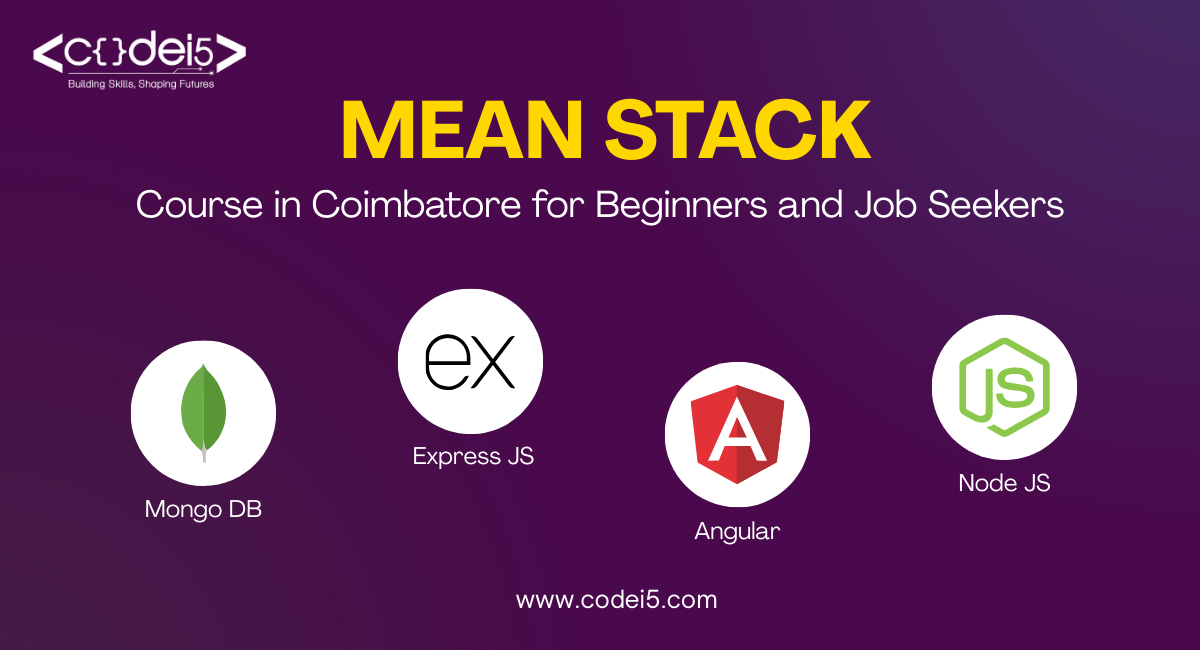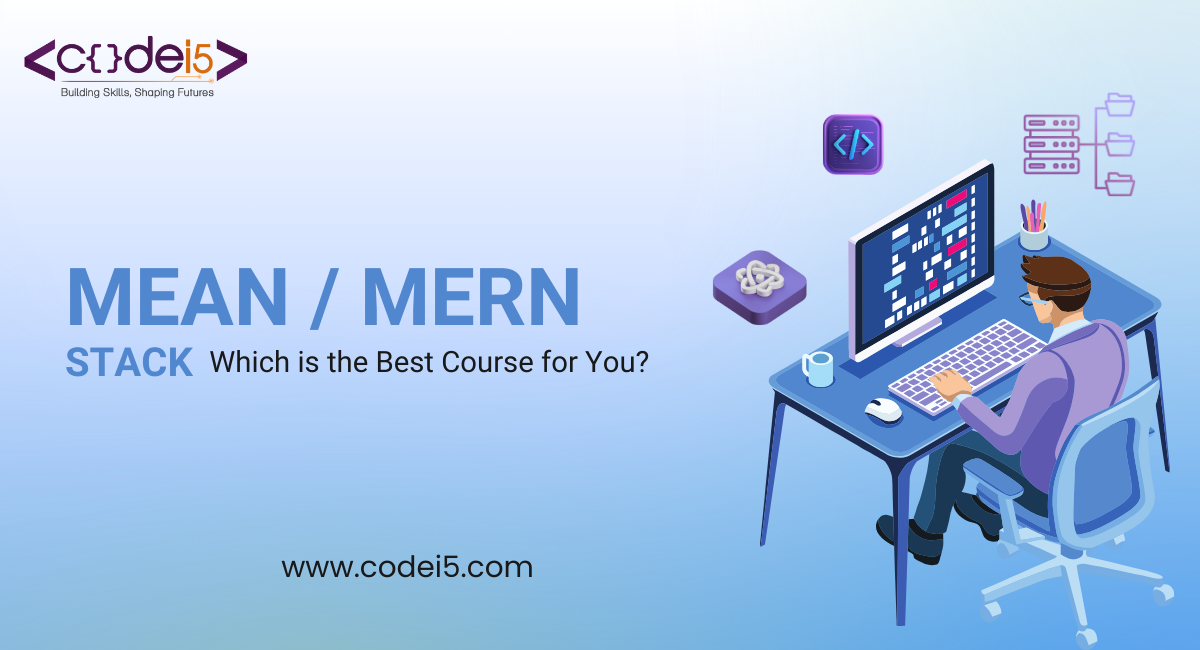
Yes, the MEAN stack can be relatively easy to learn for beginners, especially if you have a solid foundation in JavaScript. The MEAN stack—MongoDB, Express.js, Angular, and Node. js—uses JavaScript throughout the entire development process, providing a consistent and unified learning experience.
While there are some challenges, such as understanding NoSQL databases and frontend frameworks, the MEAN stack offers a clear path to building full-stack web applications.
In this blog, we’ll examine the ease of learning the MEAN stack, discuss potential challenges, and provide helpful tips to get you started with this powerful technology.
What is the MEAN Stack?
The MEAN stack is a set of tools used to build web applications. MEAN stands for MongoDB, Express.js, Angular, and Node.js. It’s popular because all these tools use JavaScript, which makes it easier to learn and use together.
Here’s a simple explanation of each part:
- MongoDB: This is a type of database that stores data in a flexible way. Unlike traditional databases that use tables, MongoDB stores data in a format that can easily grow and change.
- Express.js: This is a framework that helps build the backend of your web application. It manages how the app responds to user requests, making it an important part of the MEAN stack.
- Angular: Angular is a framework for building the frontend, or the part of the app that users see and interact with. It helps create dynamic and responsive user interfaces.
- Node.js: This is an environment that allows you to run JavaScript code on the server, not just in the browser. It makes it possible to use JavaScript for the entire application, from the backend to the frontend.
How Does It Work?
Let’s say you’re creating a simple to-do list app:
- Frontend (Angular): Angular builds the user interface where people can add, edit, or delete tasks.
- Backend (Express.js and Node.js): When someone adds a task, Angular sends a request to the backend. Express.js handles this request and saves the task in the database.
- Database (MongoDB): MongoDB stores the task so it can be retrieved later.
- Backend (Express.js): When the user wants to see their tasks, the backend fetches the tasks from MongoDB and sends them to Angular.
- Frontend (Angular): Angular then displays the tasks on the screen.
Example
A good example of a web app built with the MEAN stack is Trello, a tool used to organize tasks and projects. Trello uses Angular for its user interface, Express.js for the backend, and MongoDB to store data.
Why Learn the MEAN Stack?
Versatility:
The MEAN stack lets you build both the frontend and backend of a web application using just one language, JavaScript. This makes it easier to learn, develop, and maintain web applications since everything is done in the same language.
High Job Market Demand
The MEAN stack is very popular, which means many companies are looking for developers who know how to use it. Being skilled in all four parts of the stack makes you valuable in the job market.
Single Language Advantage
Using JavaScript for everything has several benefits:
- Consistency: You can use the same coding style throughout your project, making it easier to understand and less likely to have errors.
- Efficiency: Learning just one language saves time, especially for big projects.
- Community and Resources: The large JavaScript community offers many helpful resources, like tutorials and libraries, to support MEAN stack developers.
Why is the MEAN Stack Popular?
Benefits of Using the MEAN Stack
- One Technology for Everything: The MEAN stack gives you all the tools you need to build a web application, so you don’t need to learn different languages or technologies.
- Efficiency and Productivity: Using one language and a set of connected tools helps you work faster and more efficiently.
- Strong Community Support: The big and active JavaScript community provides lots of resources and help for MEAN stack developers.
Real-World Examples
Here are some well-known companies that use the MEAN stack:
- Trello: A popular tool for managing projects.
- PayPal: The online payment company uses the MEAN stack for some of its systems.
- Walmart: The retail giant uses it for some of its internal web applications.
These companies use the MEAN stack to create powerful, efficient, and easy-to-scale web applications.
Is the MEAN Stack Easy to Learn for Beginners?
The MEAN stack is a powerful tool for building web applications, but it can be a bit challenging for beginners. Here’s a simple guide to help you understand what it takes to learn the MEAN stack.
Challenges for Beginners
- Learning Multiple Tools: The MEAN stack includes four main tools: MongoDB, Express.js, Angular, and Node.js. Each of these has its own learning curve, so you’ll need time to get comfortable with each one.
- Understanding JavaScript: JavaScript is the main language used in the MEAN stack. You need to be comfortable with it since it’s used for both the frontend and backend.
- Building Full-Stack Applications: The MEAN stack lets you build both the part of the website users see and the part that runs on the server. If you’re new to web development, this can be a bit tricky at first.
Tips for Learning
- Focus on JavaScript First: Start by learning JavaScript well. This will make it easier to understand the other parts of the MEAN stack.
- Take It Step by Step: Don’t try to learn everything at once. Start with JavaScript, then move on to MongoDB, Express.js, and Angular. This way, it won’t feel too overwhelming.
- Practice with Small Projects: Build small, simple projects to practice what you’ve learned. This hands-on experience is the best way to understand how the MEAN stack works.
- Use Online Resources: There are many tutorials, courses, and guides available online to help you learn the MEAN stack.
Learning Curve
Learning the MEAN stack can be challenging, especially Angular, which might be a bit harder to grasp because of its complexity. But with dedication, you can get through it.
Community Support and Resources
There are many resources to help you learn the MEAN stack:
- Online Tutorials: Plenty of step-by-step guides are available online.
- Forums and Communities: Join online groups where people share tips and solve problems together.
- Documentation: Each part of the MEAN stack has detailed guides to help you learn.
If you’re looking for structured learning, Codei5 Academy offers an excellent course on the MEAN stack, especially designed for beginners.
Common Challenges and How to Overcome Them
Initial Setup Issues
- Node.js Installation: Make sure you install the correct version of Node.js.
- Package Manager Problems: If npm or yarn isn’t working, reinstall them or search online for solutions.
- Project Setup: Follow best practices for starting and setting up MEAN stack projects to avoid issues.
Debugging Tips
- Console Logging: Use console.log to check what’s happening in your code and find errors.
- Browser Tools: Use your browser’s developer tools to inspect elements and debug JavaScript.
- Error Handling: Add error handling in your code to catch and manage issues effectively.
Staying Updated
- Check for Updates: Regularly look for new versions of Angular, Node.js, and other MEAN stack tools.
- Upgrade Carefully: Test new versions in a safe environment before updating your live projects.
- Stay Informed: Follow relevant blogs and forums to keep up with the latest MEAN stack news.
Conclusion
The MEAN stack can be easy to learn, especially if you know JavaScript and are ready to learn. While there may be some challenges, mastering the MEAN stack is worth it for building full-stack web applications efficiently.
Keep practicing and don’t get discouraged. With time and effort, you’ll successfully use the MEAN stack to create great web applications.





